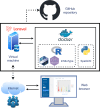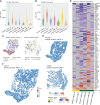spatialGE Is a User-Friendly Web Application That Facilitates Spatial Transcriptomics Data Analysis
- PMID: 39636739
- PMCID: PMC11873723
- DOI: 10.1158/0008-5472.CAN-24-2346
spatialGE Is a User-Friendly Web Application That Facilitates Spatial Transcriptomics Data Analysis
Abstract
Spatial transcriptomics (ST) is a powerful tool for understanding tissue biology and disease mechanisms. However, the advanced data analysis and programming skills required can hinder researchers from realizing the full potential of ST. To address this, we developed spatialGE, a web application that simplifies the analysis of ST data. The application spatialGE provided a user-friendly interface that guides users without programming expertise through various analysis pipelines, including quality control, normalization, domain detection, phenotyping, and multiple spatial analyses. It also enabled comparative analysis among samples and supported various ST technologies. The utility of spatialGE was demonstrated through its application in studying the tumor microenvironment of two data sets: 10× Visium samples from a cohort of melanoma metastasis and NanoString CosMx fields of vision from a cohort of Merkel cell carcinoma samples. These results support the ability of spatialGE to identify spatial gene expression patterns that provide valuable insights into the tumor microenvironment and highlight its utility in democratizing ST data analysis for the wider scientific community. Significance: The spatialGE web application enables user-friendly exploratory analysis of spatial transcriptomics data by using a point-and-click interface to guide users from data input to discovery of spatial patterns, facilitating hypothesis generation.
©2024 The Authors; Published by the American Association for Cancer Research.
Conflict of interest statement
O.E. Ospina reports grants from NIH/NCI during the conduct of the study. R. Manjarres-Betancur reports grants from NIH during the conduct of the study. I. Smalley reports grants from Melanoma Research Alliance, NIH, and American Cancer Society during the conduct of the study. J. Markowitz reports grants from TuHURA and Merck outside the submitted work, as well as a patent application for Moffitt filed unrelated to the current project pending. S.A. Eschrich reports grants from NIH/NCI during the conduct of the study, as well as a stockholder/co-founder/board member of Cvergenx, Inc., a genomic-based precision radiotherapy company. B.L. Fridley reports grants from NIH during the conduct of the study. No disclosures were reported by the other authors.
Figures




Update of
-
spatialGE: A user-friendly web application to democratize spatial transcriptomics analysis.bioRxiv [Preprint]. 2024 Jul 2:2024.06.27.601050. doi: 10.1101/2024.06.27.601050. bioRxiv. 2024. Update in: Cancer Res. 2025 Mar 03;85(5):848-858. doi: 10.1158/0008-5472.CAN-24-2346. PMID: 39005315 Free PMC article. Updated. Preprint.
Similar articles
-
spatialGE: A user-friendly web application to democratize spatial transcriptomics analysis.bioRxiv [Preprint]. 2024 Jul 2:2024.06.27.601050. doi: 10.1101/2024.06.27.601050. bioRxiv. 2024. Update in: Cancer Res. 2025 Mar 03;85(5):848-858. doi: 10.1158/0008-5472.CAN-24-2346. PMID: 39005315 Free PMC article. Updated. Preprint.
-
spatialGE: quantification and visualization of the tumor microenvironment heterogeneity using spatial transcriptomics.Bioinformatics. 2022 Apr 28;38(9):2645-2647. doi: 10.1093/bioinformatics/btac145. Bioinformatics. 2022. PMID: 35258565 Free PMC article.
-
Spatial transcriptomics in cancer research and potential clinical impact: a narrative review.J Cancer Res Clin Oncol. 2024 Jun 8;150(6):296. doi: 10.1007/s00432-024-05816-0. J Cancer Res Clin Oncol. 2024. PMID: 38850363 Free PMC article. Review.
-
ST Spot Detector: a web-based application for automatic spot and tissue detection for spatial Transcriptomics image datasets.Bioinformatics. 2018 Jun 1;34(11):1966-1968. doi: 10.1093/bioinformatics/bty030. Bioinformatics. 2018. PMID: 29360929
-
Spatial Transcriptomics in Human Cardiac Tissue.Int J Mol Sci. 2025 Jan 24;26(3):995. doi: 10.3390/ijms26030995. Int J Mol Sci. 2025. PMID: 39940764 Free PMC article. Review.
Cited by
-
Spatial Transcriptomics in Thyroid Cancer: Applications, Limitations, and Future Perspectives.Cells. 2025 Jun 19;14(12):936. doi: 10.3390/cells14120936. Cells. 2025. PMID: 40558562 Free PMC article. Review.
References
-
- Moses L, Pachter L. Museum of spatial transcriptomics. Nat Methods 2022;19:534–46. - PubMed
MeSH terms
Grants and funding
LinkOut - more resources
Full Text Sources
Medical

